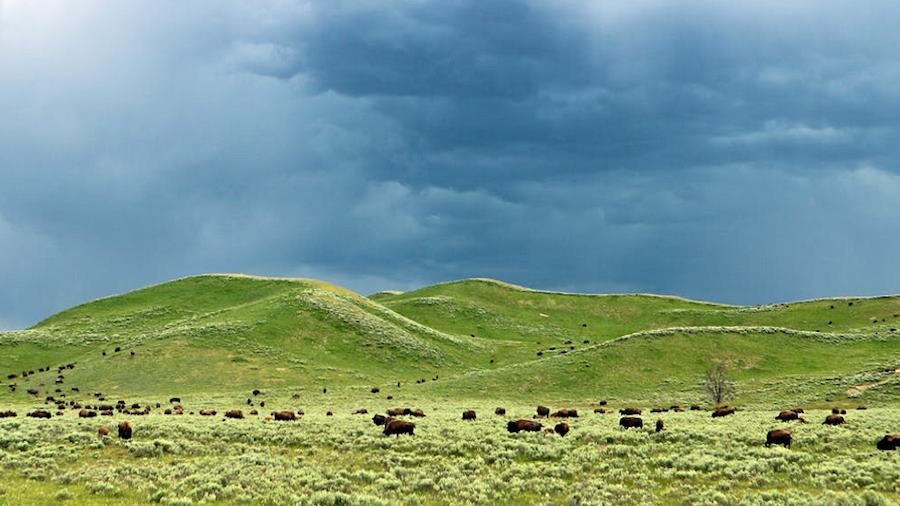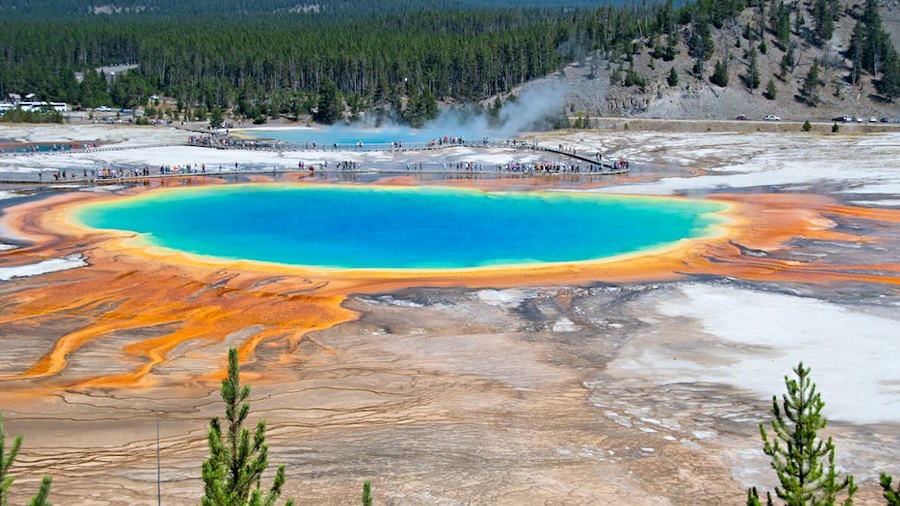THE 9 BEST Things to Do in Yellowstone National Park
What You Need to Know Before Visiting Yellowstone National Park
Contents
Yellowstone National Park is the first national park in the world and one of the most popular tourist destinations in the United States. It is known for its stunning natural beauty, including its geysers, hot springs, mudpots, and colorful canyons. Yellowstone is also home to a variety of wildlife, including bison, bears, wolves, and elk.
Are you ready to embark on a journey into the heart of natural wonder? Look no further than Yellowstone National Park, a treasure trove of breathtaking landscapes and awe-inspiring attractions. Let’s delve into the must-visit places and attractions that make Yellowstone an unparalleled destination for nature lovers and adventure seekers.
Yellowstone’s unique natural wonders draw millions of visitors from around the globe each year, making it a must-visit destination.

When to visit
The best time to visit Yellowstone National Park is during the summer months, when the weather is mild and the roads are open. However, the park can be very crowded during this time of year, so it is important to book your accommodations well in advance. If you are looking for a more peaceful experience, consider visiting during the shoulder seasons of spring and fall.
Getting there
Yellowstone National Park is located in the northwest corner of Wyoming, and it is accessible by car, bus, or plane. The nearest major airport is Jackson Hole Airport (JAC), which is located about 60 miles from the park’s south entrance. There is also a smaller airport in Cody, Wyoming (COD), which is located about 50 miles from the park’s east entrance.
What to see and do
There is something for everyone at Yellowstone National Park. Here are just a few of the many attractions that you can see and do during your visit:
Old Faithful:
What is the number one attraction at Yellowstone?
Prepare to be mesmerized by the iconic Old Faithful Geyser, a natural marvel that erupts with impressive regularity. Witnessing its powerful spray against the backdrop of the park’s pristine wilderness is a sight you’ll never forget.
Old Faithful is the most famous geyser in Yellowstone National Park, and it is known for its regular eruptions. Every 35-90 minutes, Old Faithful erupts for about 1-5 minutes, shooting a stream of hot water up to 184 feet into the air.
Grand Prismatic Spring:
Grand Prismatic Spring is the largest hot spring in the United States, and it is known for its vibrant colors. The spring is surrounded by a rainbow of colors, including blue, green, orange, and red.
Yellowstone Canyon:
Yellowstone Canyon is a spectacular gorge that is carved by the Yellowstone River, a striking geological formation featuring colorful rock walls, cascading waterfalls, and hiking trails offering panoramic views. It’s a photographer’s paradise and a hiker’s dream.
The canyon is up to 800 feet deep and 1,200 feet wide, and it offers stunning views of the river and the surrounding cliffs.
Mammoth Hot Springs:
Mammoth Hot Springs is a series of terraced hot springs that are located in the northern part of Yellowstone National Park. The springs are known for their unique formations, which are created by the mineral-rich water.
Discover the otherworldly beauty of Mammoth Hot Springs, where intricate terraces of travertine formations create a surreal landscape. The vibrant colors and steaming pools make it a must-see destination within the park.
Wildlife:

Yellowstone National Park is home to a variety of wildlife, including bison, bears, wolves, and elk. You can see wildlife all over the park, but some of the best places to spot them are in the Hayden Valley, Lamar Valley, and the Blacktail Plateau Drive.
Keep your camera ready for unforgettable encounters with these magnificent creatures.
Yellowstone Lake:
Explore the vast Yellowstone Lake, a serene expanse of water surrounded by snow-capped peaks. It offers opportunities for fishing, kayaking, and simply basking in the tranquility of nature.
Artist Point:
Capture the postcard-perfect views at Artist Point, a viewpoint overlooking the Lower Falls of the Yellowstone River. The combination of the waterfall’s power and the canyon’s grandeur creates a sight that will leave you in awe.
Norris Geyser Basin:
Step into the otherworldly landscape of Norris Geyser Basin, the park’s hottest and most dynamic thermal area. Explore its geysers, hot springs, and fumaroles, showcasing the Earth’s geothermal wonders.
When planning your Yellowstone adventure, be sure to explore these extraordinary places and attractions. Each corner of the park tells a unique story of nature’s marvels. Whether you’re captivated by geothermal features, mesmerized by waterfalls, or thrilled by wildlife encounters, Yellowstone National Park promises an unforgettable experience.
Tips for visitors
Here are a few tips for visitors to Yellowstone National Park:
- Book your accommodations well in advance, especially if you are visiting during the summer months.
- Purchase a National Parks Pass if you are planning on visiting multiple national parks during your trip.
- Be aware of your surroundings and take precautions to avoid encounters with wildlife.
- Bring plenty of water and snacks, as there are limited dining options available in the park.
- Wear comfortable shoes and clothing, as you will be doing a lot of walking.
Yellowstone National Park is a truly amazing place, and it is a must-see for any visitor to the United States. With its stunning natural beauty and abundance of wildlife, Yellowstone is sure to leave a lasting impression.
Where exactly is Yellowstone National Park located?
Yellowstone National Park is located in the northwestern United States, primarily in the state of Wyoming. It also extends into Montana and Idaho. The park is approximately 63 miles north to south and 54 miles east to west.
Yellowstone has five entrances: North, Northeast, East, South, and West. The North Entrance is located near Gardiner, Montana, the Northeast Entrance is located near Cooke City, Montana, the East Entrance is located near Cody, Wyoming, the South Entrance is located near Jackson, Wyoming, and the West Entrance is located near West Yellowstone, Montana.
Yellowstone is a popular tourist destination, and it is important to book your accommodations and activities in advance, especially if you are visiting during the summer months.
How long is the wait to get into Yellowstone National Park?
The wait time to get into Yellowstone National Park varies depending on the time of day, the day of the week, and the time of year. Generally speaking, the wait times are longest during the summer months, on weekends, and during the middle of the day.
Check Live Yellowstone Web Cams
To avoid long wait times, it is recommended to arrive at the park early in the morning or late in the afternoon. You can also check the park’s website for current wait times before you go.
Here are some estimated wait times for different times of day and days of the week:
Summer months
- Morning (8am-10am): 30-60 minutes
- Midday (10am-2pm): 1-2 hours
- Afternoon (2pm-4pm): 30-60 minutes
Weekdays
- Morning (8am-10am): 15-30 minutes
- Midday (10am-2pm): 30-60 minutes
- Afternoon (2pm-4pm): 15-30 minutes
Shoulder season (spring and fall)
- Morning (8am-10am): 5-15 minutes
- Midday (10am-2pm): 15-30 minutes
- Afternoon (2pm-4pm): 5-15 minutes
Winter months
- Morning (8am-10am): 5-10 minutes
- Midday (10am-2pm): 10-15 minutes
- Afternoon (2pm-4pm): 5-10 minutes
It is important to note that these are just estimates, and the actual wait times may vary depending on the conditions.
Is Yellowstone in Montana or Wyoming?
Yellowstone National Park is primarily located in the U.S. state of Wyoming, although it also extends into Montana and Idaho. The majority of the park’s area is in Wyoming, making it the primary state where Yellowstone is situated.
What is the best month to visit Yellowstone National Park?
The best month to visit Yellowstone National Park largely depends on your preferences for weather, crowds, and the activities you want to enjoy. Generally, the summer months of June, July, and August are the most popular, offering pleasant weather, with daytime temperatures ranging from 70°F to 80°F (21°C to 27°C). During this time, the park is bustling with visitors, and all facilities and roads are open.
If you prefer fewer crowds and still relatively mild weather, consider visiting in the shoulder seasons of late spring (May) or early fall (September and early October). During these months, you can enjoy thinner crowds, vibrant wildflowers in spring, and the beautiful autumn foliage in fall.
For wildlife enthusiasts, late spring (May and early June) is an excellent time to visit, as animals are often more active during this period.
Winter (December to February) is ideal for visitors interested in a unique snow-covered experience, with opportunities for activities like snowmobiling, cross-country skiing, and observing wildlife in a tranquil setting. However, many roads and facilities are closed or limited during the winter months.
Ultimately, the best time to visit Yellowstone depends on your preferences for weather, activities, and crowd levels. Consider these factors when planning your trip to make the most of your Yellowstone experience.
Explore Yellowstone’s natural wonders safely with our essential Yellowstone safety guide. Learn about wildlife encounters, geothermal feature precautions, and weather awareness. Discover expert tips on maintaining a safe distance from animals and staying on designated trails. Plan your visit confidently, knowing the best practices to protect both yourself and the park’s precious ecosystem. Experience the beauty of Yellowstone while prioritizing your safety. Dive into a worry-free adventure today!
Yellowstone National Park
wikipedia: Yellowstone National Park
